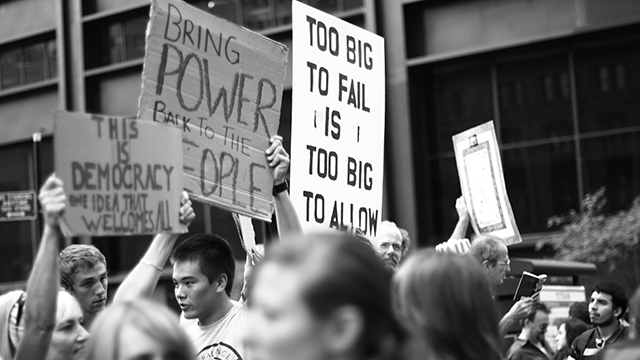This post first appeared at Campaign for America’s Future.

Occupy Wall St protest in 2011. (Photo: Aaron Bauer/flickr CC 2.0)
There’s been a lot of economic recovery talk lately, but most people will probably tell you that things still aren’t that great. Most Americans – 99 percent of them or so – are still struggling. Economic inequality is soaring, social mobility is declining, earnings at most income levels are stagnant or falling, and the percentage of working-age Americans who are actually working is at a record low.
And yet, as Republicans take control of the Senate and consolidate their lock on the House, they’re preparing to double down on the same policies that created this mess in the first place: austerity, taxation and deregulation.
How will Democrats respond? The economy has improved somewhat, but in an uneven and unstable way that has primarily benefited the wealthy. (And now the GOP’s even trying to take credit for that.) How will the Republicans’ opponents distinguish themselves: with clear and concrete ideas and proposals, or vague platitudes?
Whose Inequality?
Lately even some of the more corporate-friendly Democrats have been incorporating inequality into their rhetoric. Wages and social mobility sometimes get a nod, too, usually with the word “opportunity” in there somewhere.
But name-checking the problem isn’t going to be enough. “Opportunity” is a time-worn Republican catchphrase, and inequality without specificity is hard to for voters to wrap their heads around. Inequality must be connected with the lived experience of most Americans, translated from the realm of abstraction into the world of concrete through specific proposals. But which ones?
Last month there was a heated debate among liberals, triggered by Ezra Klein’s objection to President Obama’s statement that inequality is “the defining challenge of our time.” Klein argued that the “defining challenges” were growth and unemployment, writing:
A world in which inequality is the top concern is a world in which raising taxes on the rich is perhaps the most important policy choice the government can make. A world in which growth and unemployment are top concerns are worlds in which very different policies – from stimulus spending to permitting more inflation – might be the top priorities.
A number of people responded. Economist Dean Baker responded that “inequality and unemployment are the same problem.” Lawrence Mishel of the Economic Policy Institute reframed the “defining challenge” as “broad-based wage growth.” Paul Krugman observed that inequality is staggering in its scope, reflects a breakdown in our political economy, and could form the core of a populist message.
A number of commenters noted, correctly, that Klein’s making an artificial distinction. Inequality is woven into the fabric of our troubled economy, and will need to be addressed in a number of interconnected ways.
More Jobs, Better Wages, Robust Growth
But how, exactly, can the equality or economic fairness agenda be translated into a galvanizing message – one that is backed by concrete policy proposals?
We’ve already seen populist messaging that works, such as Sen. Elizabeth Warren’s (D-MA) much-repeated statement that the “rules are rigged” for the few at the expense of the many. But what would the economic goals of an un-rigged economy look like? The broad-brush answer could be defined “more jobs,” “better wages” and “robust growth” — defined as growth that brings broad prosperity and isn’t subject to boom-and-bust cycles.
We saw economic growth in the last quarter. But robust growth should lead to rising wages, and we didn’t see that.
All of these goals, in fact, go hand-in-hand. You can’t reduce unemployment significantly or raise wages substantially unless the economy is growing in a strong and stable way. That requires an expansion of the sectors of the economy that create human work – doing things like building, managing, serving, teaching and healing. You can’t get there by inflating stock-market bubbles or driving an ever-increasing percentage of corporate profits through the non-productive banking sector.
That’s why Sen. Bernie Sanders’ (I-VT) $1 trillion infrastructure proposal makes sense, both financially and politically. People understand that roads and bridges need repair, and they know that projects like these create well-paying jobs (13 million of them, according to Sen. Sanders). They also understand, at least intuitively, that there is a connection between lower employment and higher wages because employers have to compete for available workers.
The Sanders proposal is effective because it speaks to this clearly defined anti-inequality agenda: more jobs, better wages, robust growth. (It’s also reasonably prudent. The American Society of Civil Engineers thinks we need to spend $3.6 trillion by 2020 – more than three and a half times as much as the Sanders proposal – to bring our infrastructure up to snuff.)
The infrastructure proposal turns an abstract set of goals into something concrete – literally, in this case.
Inequality Made Concrete
There are other ways to make the fairness agenda concrete. People understand that millions of jobs were lost in the last financial crisis. They’re aware that their income has fallen behind since then, as the wealthy have moved ahead. And they understand that rich people and corporations aren’t paying very much in taxes nowadays.
Inequality has also been fueled by soaring compensation packages for senior corporate executives – packages that are driven by short-term stock gains, not long-term performance. As a result, executives have been pressing to increase their own earnings through mergers, outsourcing, layoffs and other short-term strategies that harm the long-term goals: more jobs, better wages and robust growth.
More broadly, income inequality reflects a breakdown in societal controls on a variety of levels – from regulatory capture to weakened corporate governance, from the growing financialization of our economy to the increasing social acceptability of naked greed among our nation’s elites.
These problems have concrete solutions. We’ll need more direct government investment in the productive economy. (The infrastructure proposal is an excellent start.) And while funding for that investment will come from a number of sources, some of it will undoubtedly be raised by taxing the privileged few – so yes, higher taxes for billionaires and corporations are in the mix.
We’ll need to ensure the future stability of our economy to prevent future job-killing recessions. That means more financial regulation and a breakup of the big banks. And society’s values will need to evolve toward a new, post-Gordon Gekko mindset in which greed is no longer considered “good” – much less something to be celebrated, feted and lionized by politicians and the media.
All of these proposals meet the same set of goals: more jobs, higher wages and more robust growth. (We’ll just have to hope that the Federal Reserve doesn’t intervene with an interest-rate hike, which could tighten the labor market again.)
Litmus Test
The “jobs/wages/growth” agenda provides a useful litmus test for less progressive proposals, too: Tell us, Senator (or Mr. President), how would your new trade bill create jobs, increase our wages, or lead to robust growth?
What about your tax cuts, Mr. Speaker, or those spending cuts you keep pushing? How does cutting Social Security benefits get us more jobs or better wages?
Oh, and please be specific.
Carrying The Banner
Specificity is the key. Generalities no longer suffice. It is, as they say, time to get real.
It’s true that bills like Sanders’ won’t become law in this Congress, but that’s not the point. As soul singer Bobby Womack used to say, “Sometimes you gotta lose to win.” By presenting common-sense populist proposals, progressives can show voters who’s fighting for their interests – and who’s working against them. That kind of spectacle can motivate people to go to the polls, in 2016 and beyond.
You can define the problem as inequality, or wage stagnation, or unemployment, or lack of social mobility. Each of these challenges is reflective of a singular whole: an economy that either works for the few or for the many. The goal is to demonstrate how we can change our economy to meet people’s day-to-day needs – for jobs, a decent income and long-term financial security. That’s why the choice posed by Klein and others is a false one.
The true choice for Democrats is this: Will they carry the jobs/wages/growth banner, or settle for rhetorical feints in populism’s direction? Polling, as assembled here and elsewhere, makes it clear that the public strongly supports a populist agenda built around specific and concrete economic goals. There is no polling to suggest that vagueness or platitudes – sometimes called “messaging” – is a substitute for bold and direct action.
“When the left next gets a chance to make economic policy,” asked Klein, “what will they choose to do?” But if Democrats don’t make the right choice now, they may not have the chance to make economic policy – not for a long time to come.
The views expressed in this post are the author’s alone, and presented here to offer a variety of perspectives to our readers.


